Transforming Vulnerable Urban Areas: An IMM-Driven Resilience Strategy for Heat and Flood Challenges in Rio de Janeiro’s Cidade Nova
Abstract
1. Introduction
2. Materials and Methods
2.1. Study Area
2.2. Data Collection and Processing
2.3. Methodology
3. Results
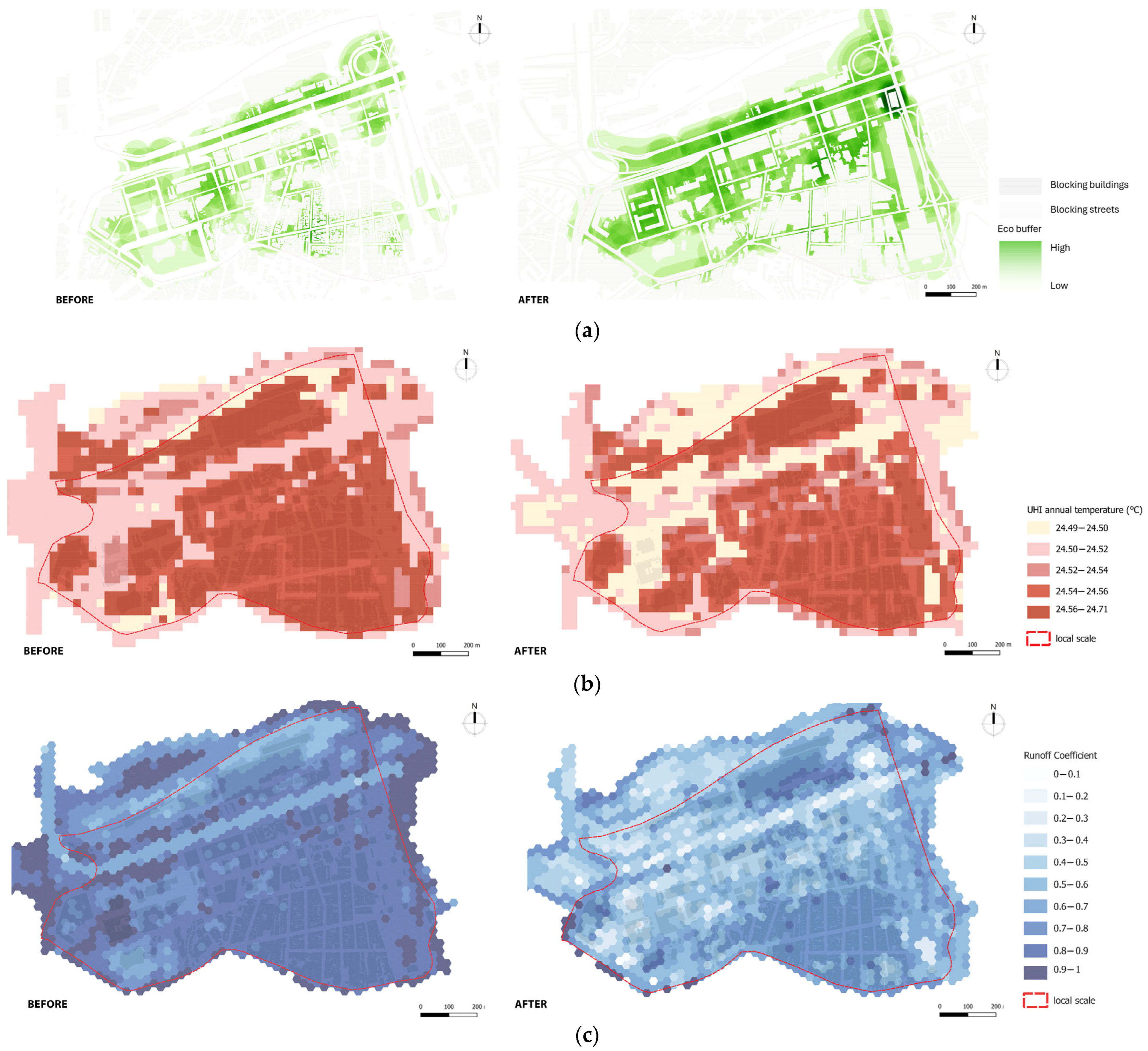
4. Discussion
4.1. Replication and Transferability of the IMM Framework
4.2. Implementation Challenges
4.3. Research Limitations
- (1)
- The corridor located along the coastal area can protect coastal habitats, filter contaminants, and alleviate the risk of sea levels rising;
- (2)
- The central corridors along the east–west side of the Cidade Nova district reaching Guanabara Bay can enhance water quality and flood management, erosion control, and hydrological connectivity;
- (3)
- The main east–west artery along Av. Presidente Vargas is providing a vegetation buffer zone to mitigate the negative effects of traffic;
- (4)
- The western part of the boundary connecting Tijuca to Maracanã can restore water canals, provide wetland habitats, enhance hydrological connectivity, and manage floods.
5. Conclusions
Author Contributions
Funding
Data Availability Statement
Acknowledgments
Conflicts of Interest
References
- Prefeitura do Rio de Janeiro. Plano de Adaptação Climática da Cidade do Rio de Janeiro. 2021. Available online: https://www.google.com/search?q=Rio+Municipal+Climate+Change+Adaptation+Plan (accessed on 1 May 2025).
- Sotto, D.; Philippi, A.; Yigitcanlar, T.; Kamruzzaman, M. Aligning Urban Policy with Climate Action in the Global South: Are Brazilian Cities Considering Climate Emergency in Local Planning Practice? Energies 2019, 12, 3418. [Google Scholar] [CrossRef]
- Nobre, C.A.; Marengo, J.A.; Soares, W.R. Climate Change Risks in Brazil; Springer: Berlin/Heidelberg, Germany, 2018; pp. 1–226. [Google Scholar]
- Field, C. Managing the Risks of Extreme Events and Disasters to Advance Climate Change Adaptation: Special Report of the Intergovernmental Panel on Climate Change. 2012. Available online: https://www.ipcc.ch/report/managing-the-risks-of-extreme-events-and-disasters-to-advance-climate-change-adaptation/ (accessed on 1 May 2025).
- Soler, L.S.; Gregorio, L.T.; Leal, P.; Gonçalves, D.; Londe, L.; Soriano, É.; Cardoso, J.; Coutinho, M.; Santos, L.B.; Saito, S. Challenges and Perspectives of Innovative Digital Ecosystems Designed to Monitor and Warn Natural Disasters in Brazil. In Proceedings of the 5th International Conference on Management of Emergent Digital EcoSystems, MEDES, Luxembourg, 29–31 October 2013; pp. 254–261. [Google Scholar]
- Peres, L.F.; Lucena, A.J.; Rotunno Filho, O.C.; França, J.R. The Urban Heat Island in Rio de Janeiro, Brazil, in the Last 30 Years Using Remote Sensing Data. Int. J. Appl. Earth Obs. Geoinf. 2018, 64, 104–116. [Google Scholar] [CrossRef]
- Marcus, L.; Colding, J. Toward an Integrated Theory of Spatial Morphology and Resilient Urban Systems. Ecol. Soc. 2014, 19, 4. [Google Scholar] [CrossRef]
- Feliciotti, A.; Romice, O.; Porta, S. Design for Change: Five Proxies for Resilience in the Urban Form. Open House Int. 2016, 41, 23–30. [Google Scholar] [CrossRef]
- Sharifi, A.; Yamagata, Y. Resilient Urban Form: A Conceptual Framework. Lect. Notes Energy 2018, 65, 167–179. [Google Scholar]
- Pan, Y.; Jiao, S.; Hu, J.; Guo, Q.; Yang, Y. An Ecological Resilience Assessment of a Resource-Based City Based on Morphological Spatial Pattern Analysis. Sustainability 2024, 16, 6476. [Google Scholar] [CrossRef]
- Liu, B.; Guo, X.; Jiang, J. How Urban Morphology Relates to the Urban Heat Island Effect: A Multi-Indicator Study. Sustainability 2023, 15, 10787. [Google Scholar] [CrossRef]
- Oke, T.R. Street Design and Urban Canopy Layer Climate. Energy Build. 1988, 11, 103–113. [Google Scholar] [CrossRef]
- Meerow, S.; Newell, J.P.; Stults, M. Defining Urban Resilience: A Review. Landsc. Urban Plan. 2016, 147, 38–49. [Google Scholar] [CrossRef]
- Olazabal, M. Resilience, Sustainability and Transformability of Cities as Complex Adaptive Systems. In Urban Regions Now & Tomorrow; Springer: Berlin/Heidelberg, Germany, 2017; pp. 73–97. [Google Scholar]
- Baoxing, Q. Resilient Urban Design Methods and Principles Based on the Complex Adaptive System Theory. Landsc. Archit. Front. 2018, 6, 42–47. Available online: https://link.gale.com/apps/doc/A568370893/AONE?u=anon~219f3012&sid=googleScholar&xid=4fd9307e (accessed on 13 May 2025). [CrossRef]
- Shi, Y.; Zhai, G.; Xu, L.; Zhou, S.; Lu, Y.; Liu, H.; Huang, W. Assessment Methods of Urban System Resilience: From the Perspective of Complex Adaptive System Theory. Cities 2021, 112, 103141. [Google Scholar] [CrossRef]
- Muñoz-Erickson, T.A.; Meerow, S.; Hobbins, R.; Cook, E.; Iwaniec, D.M.; Berbés-Blázquez, M.; Grimm, N.B.; Barnett, A.; Cordero, J.; Gim, C.; et al. Beyond Bouncing Back? Comparing and Contesting Urban Resilience Frames in US and Latin American Contexts. Landsc. Urban Plan. 2021, 214, 104173. [Google Scholar] [CrossRef]
- Spaans, M.; Waterhout, B. Building Up Resilience in Cities Worldwide—Rotterdam as Participant in the 100 Resilient Cities Programme. Cities 2017, 61, 109–116. [Google Scholar] [CrossRef]
- Rio de Janeiro. Rio Resiliente Resilience Strategy of the City of Rio de Janeiro. 2015. Available online: https://www.santiagoresiliente.cl/wp-content/uploads/2017/05/5.2.2.-estra_res_rio_ingles_2-1.pdf (accessed on 13 May 2025).
- Chelleri, L.; Waters, J.J.; Olazabal, M.; Minucci, G. Resilience Trade-offs: Addressing Multiple Scales and Temporal Aspects of Urban Resilience. Environ. Urban. 2015, 27, 181–198. [Google Scholar] [CrossRef]
- Aram, F.; García, E.H.; Solgi, E.; Mansournia, S. Urban Green Space Cooling Effect in Cities. Heliyon 2019, 5, e01339. [Google Scholar] [CrossRef]
- Rahman, M.A.; Stratopoulos, L.M.; Moser-Reischl, A.; Zölch, T.; Häberle, K.H.; Rötzer, T.; Pretzsch, H.; Pauleit, S. Traits of Trees for Cooling Urban Heat Islands: A Meta-Analysis. Build. Environ. 2020, 170, 106606. [Google Scholar] [CrossRef]
- Yu, Z.; Yang, G.; Zuo, S.; Jørgensen, G.; Koga, M.; Vejre, H. Critical Review on the Cooling Effect of Urban Blue-Green Space: A Threshold-Size Perspective. Urban For. Urban Green. 2020, 49, 126630. [Google Scholar] [CrossRef]
- Ampatzidis, P.; Kershaw, T. A Review of the Impact of Blue Space on the Urban Microclimate. Sci. Total Environ. 2020, 730, 139068. [Google Scholar] [CrossRef] [PubMed]
- Sahani, J.; Kumar, P.; Debele, S.; Spyrou, C.; Loupis, M.; Aragão, L.; Porcù, F.; Shah, M.A.R.; Di Sabatino, S. Hydro-Meteorological Risk Assessment Methods and Management by Nature-Based Solutions. Sci. Total Environ. 2019, 696, 133936. [Google Scholar] [CrossRef]
- Debele, S.E.; Kumar, P.; Sahani, J.; Marti-Cardona, B.; Mickovski, S.B.; Leo, L.S.; Porcù, F.; Bertini, F.; Montesi, D.; Vojinovic, Z.; et al. Nature-Based Solutions for Hydro-Meteorological Hazards: Revised Concepts, Classification Schemes and Databases. Environ. Res. 2019, 179, 108799. [Google Scholar] [CrossRef]
- Davies, C.; Chen, W.Y.; Sanesi, G.; Lafortezza, R. The European Union Roadmap for Implementing Nature-Based Solutions: A Review. Environ. Sci. Policy 2021, 121, 49–67. [Google Scholar] [CrossRef]
- Henud, I.R.; Póvoa, A.A.; Tavares, M.G.; Soares-Gomes, A. Coastal Resilience and Adaptation Strategies: Natural Habitats for Coastal Protection and Atlantic Forest Restoration on the Coast of the Rio de Janeiro State. Int. J. Disaster Risk Reduct. 2024, 113, 104861. [Google Scholar] [CrossRef]
- Santos, L.B. Nature-Based Solutions in Urban Periphery Communities in Brazil. Soc. Impacts 2024, 3, 100050. [Google Scholar] [CrossRef]
- Nature-Based Solutions in the Favelas’ Presented in Parallel to the G20. Available online: https://rioonwatch.org/?p=80117 (accessed on 13 May 2025).
- Snep, R.P.; Voeten, J.G.; Mol, G.; Van Hattum, T. Nature Based Solutions for Urban Resilience: A Distinction Between No-Tech, Low-Tech and High-Tech Solutions. Front. Environ. Sci. 2020, 8, 599060. [Google Scholar] [CrossRef]
- Bush, J.; Doyon, A. Building Urban Resilience with Nature-Based Solutions: How Can Urban Planning Contribute? Cities 2019, 95, 102483. [Google Scholar] [CrossRef]
- Young, A.F.; Marengo, J.A.; Coelho, J.O.M.; Scofield, G.B.; de Oliveira Silva, C.C.; Prieto, C.C. The Role of Nature-Based Solutions in Disaster Risk Reduction: The Decision Maker’s Perspectives on Urban Resilience in São Paulo State. Int. J. Disaster Risk Reduct. 2019, 39, 101219. [Google Scholar] [CrossRef]
- Plano de Renovação da Cidade Nova. Available online: https://storymaps.arcgis.com/collections/3fb748eebc534a4bb98a657d83a2cb7d (accessed on 29 May 2025).
- Almeida Neto, D.J.; Heller, L. Which is Riskier: Life on the Floodplain or in Housing Imposed from Above? The Case of Flood-Prone Areas in Rio Branco, Acre, Brazil. Environ. Urban. 2016, 28, 169–182. [Google Scholar] [CrossRef]
- Beck, H.E.; McVicar, T.R.; Vergopolan, N.; Berg, A.; Lutsko, N.J.; Dufour, A.; Zeng, Z.; Jiang, X.; van Dijk, A.I.J.M.; Miralles, D.G. High-Resolution (1 Km) Köppen-Geiger Maps for 1901–2099 Based on Constrained CMIP6 Projections. Sci. Data 2023, 10, 724. [Google Scholar] [CrossRef]
- POP.INFO: Censo 2022|DATA RIO. Available online: https://www.data.rio/apps/PCRJ::pop-info-censo-2022/about?path= (accessed on 18 May 2025).
- DATA RIO. Available online: https://datariov2-pcrj.hub.arcgis.com/ (accessed on 20 July 2025).
- Ladybug Tools|Food4Rhino. Available online: https://www.food4rhino.com/en/app/ladybug-tools (accessed on 20 July 2025).
- IPTU—Regularization of Registration Data—Carioca Digital Portal. Available online: https://carioca.rio/servicos/iptu-regularizacao-de-dados-cadastrais/ (accessed on 22 July 2025).
- Cobertura Vegetal e Uso da Terra 2018|DATA RIO. Available online: https://www.data.rio/datasets/c32974e0db954842b7af9a4816d7a821_0/about (accessed on 20 July 2025).
- Weather Data Center. Available online: https://www.ashrae.org/technical-resources/bookstore/weather-data-center (accessed on 20 July 2025).
- EarthExplorer. Available online: https://earthexplorer.usgs.gov/ (accessed on 20 July 2025).
- Tadi, M.; Vahabzadeh Manesh, S.; Mohammad Zadeh, M.H. Urban Morphology, Environmental Performances, and Energy Use: Neighborhood Transformation in Rio de Janeiro via IMM. J. Archit. Eng. Technol. 2017, 5, 180. [Google Scholar]
- Breuste, J.; Qureshi, S.; Li, J. Scaling Down the Ecosystem Services at Local Level for Urban Parks of Three Megacities. Hercynia 2013, 46, 1–20. Available online: https://www.academia.edu/download/53183342/Scaling_down_the_ecosystem_services_at_l20170518-21584-qe1i4e.pdf (accessed on 29 May 2025).
- Grunwald, L.; Heusinger, J.; Weber, S. A GIS-Based Mapping Methodology of Urban Green Roof Ecosystem Services Applied to a Central European City. Urban For. Urban Green. 2017, 22, 54–63. [Google Scholar] [CrossRef]
- Dormidontova, V.; Belkin, A. The Continuity of Open Greened Spaces—Basic Principle of Urboecology. IOP Conf. Ser. Mater. Sci. Eng. 2020, 753, 022048. [Google Scholar] [CrossRef]
- Bennett, G.; Wit, P.D. The Development and Application of Ecological Networks: A Review of Proposals, Plans and Programmes; International Union for Conservation of Nature (IUCN): Gland, Switzerland, 2001. [Google Scholar]
- Hilty, J.; Worboys, G.; Keeley, A.; Woodley, S.; Lausche, B. Guidelines for Conserving Connectivity Through Ecological Networks and Corridors. 2020. Available online: https://www.researchgate.net/profile/Jamie-Pittock/publication/342749223_Guidelines_for_conserving_connectivity_through_ecological_networks_and_corridors/links/5f057da74585155050947d43/Guidelines-for-conserving-connectivity-through-ecological-networks-and-corridors.pdf (accessed on 3 July 2025).
- Hagishima, A. Green Infrastructure and Urban Sustainability. AIP Conf. Proc. 2018, 1931, 020002. [Google Scholar] [CrossRef]
- Kumakoshi, Y.; Chan, S.Y.; Koizumi, H.; Li, X.; Yoshimura, Y. Standardized Green View Index and Quantification of Different Metrics of Urban Green Vegetation. Sustainability 2020, 12, 7434. [Google Scholar] [CrossRef]
- Simpkins, C.E.; Dennis, T.E.; Etherington, T.R.; Perry, G.L.W. Assessing the Performance of Common Landscape Connectivity Metrics Using a Virtual Ecologist Approach. Ecol. Modell. 2018, 367, 13–23. [Google Scholar] [CrossRef]
- Bolund, P.; Hunhammar, S. Ecosystem Services in Urban Areas. Ecol. Econ. 1999, 29, 293–301. [Google Scholar] [CrossRef]
- National Research Council. Division on Earth and Life Studies, Water Science and Technology Board, Committee on Reducing Stormwater Discharge Contributions to Water Pollution. Urban Stormwater Management in the United States; National Academies Press: Washington, DC, USA, 2009. [Google Scholar]
- Chow, V.T.; Maidment, D.R.; Mays, L.W. Applied Hydrology; McGraw-Hill: New York, NY, USA, 1988. [Google Scholar]
- Tadi, M.; Manesh, S.V. Transformation of an Urban Complex System into a More Sustainable Form Via Integrated Modification Methodology (IMM). Int. J. Sustain. Dev. Plan. 2014, 9, 514–537. [Google Scholar] [CrossRef]
- Tadi, M.; Manesh, V.; Mohammad, M.H.; Zaniol, F. Transforming Urban Morphology and Environmental Performances via IMM® The Case of PortoMaravilha in Rio de Janeiro. GSTF J. Eng. Technol. 2014, 3, 13. [Google Scholar] [CrossRef]
- World Health Organisation. Urban Green Spaces: A Brief for Action; World Health Organisation: Geneva, Switzerland, 2017. [Google Scholar]
- Huang, Y.; Yang, J.; Chen, J.; Shi, H.; Lu, X. Association between ambient temperature and age-specific mortality from the elderly: Epidemiological evidence from the Chinese prefecture with most serious aging. Environ. Res. 2022, 211, 113103. [Google Scholar] [CrossRef]
- Braga, A.L.; Zanobetti, A.; Schwartz, J. The effect of weather on respiratory and cardiovascular deaths in 12 US cities. Environ. Health Perspect. 2002, 110, 859–863. [Google Scholar] [CrossRef]
- Tadi, M.; Zadeh, M.H.; Biraghi, C.A. The Integrated Modification Methodology. In Environmental Performance and Social Inclusion in Informal Settlements: A Favela Project Based on the IMM Integrated Modification Methodology; Springer: Berlin/Heidelberg, Germany, 2020; pp. 15–37. [Google Scholar]
- Bennett, G.; Mulongoy, K.J. Review of Experience with Ecological Networks, Corridors and Buffer Zones; Technical Series No. 23; Secretariat of the Convention on Biological Diversity: Montreal, QC, Canada, 2006; 100p. [Google Scholar]
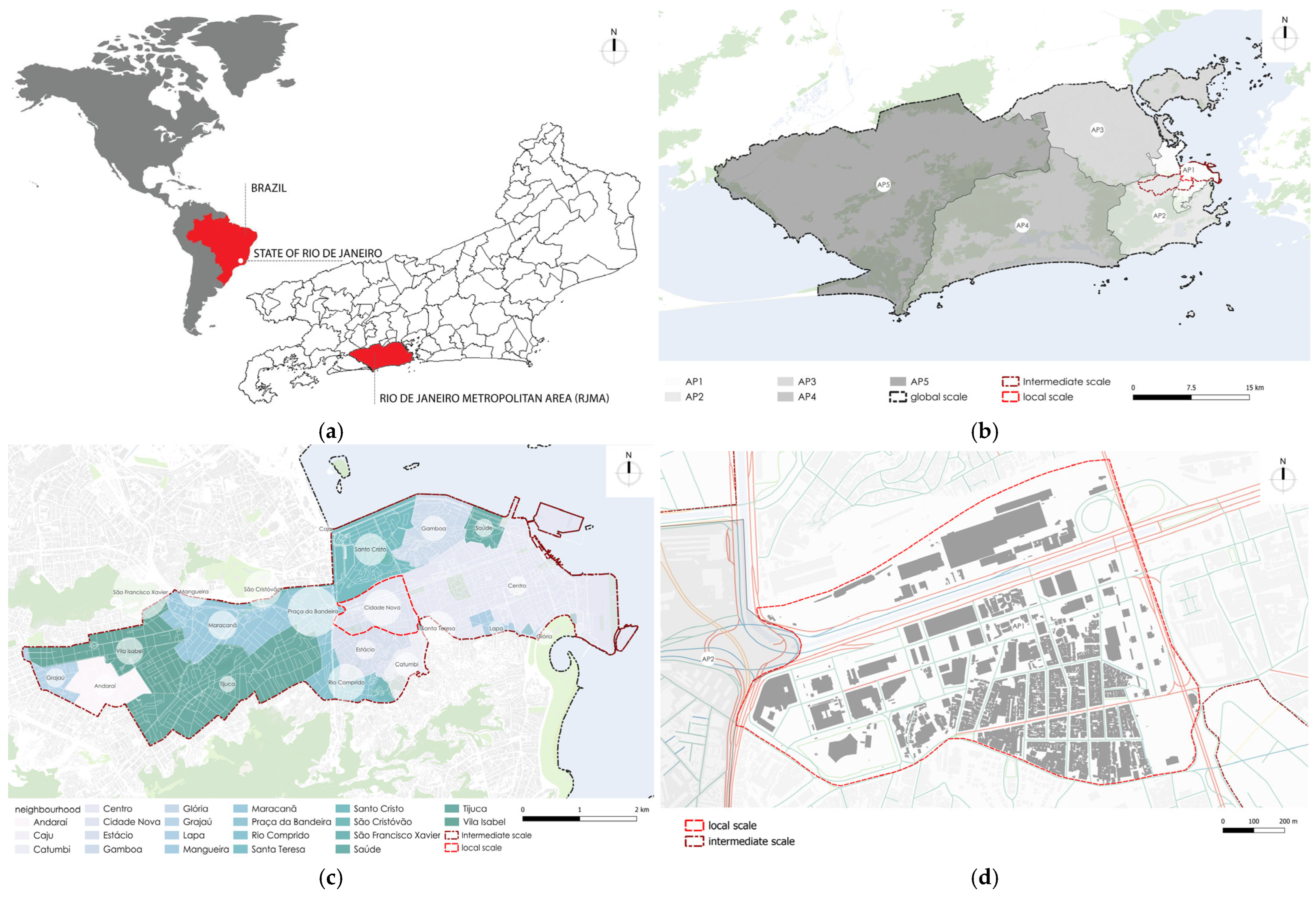
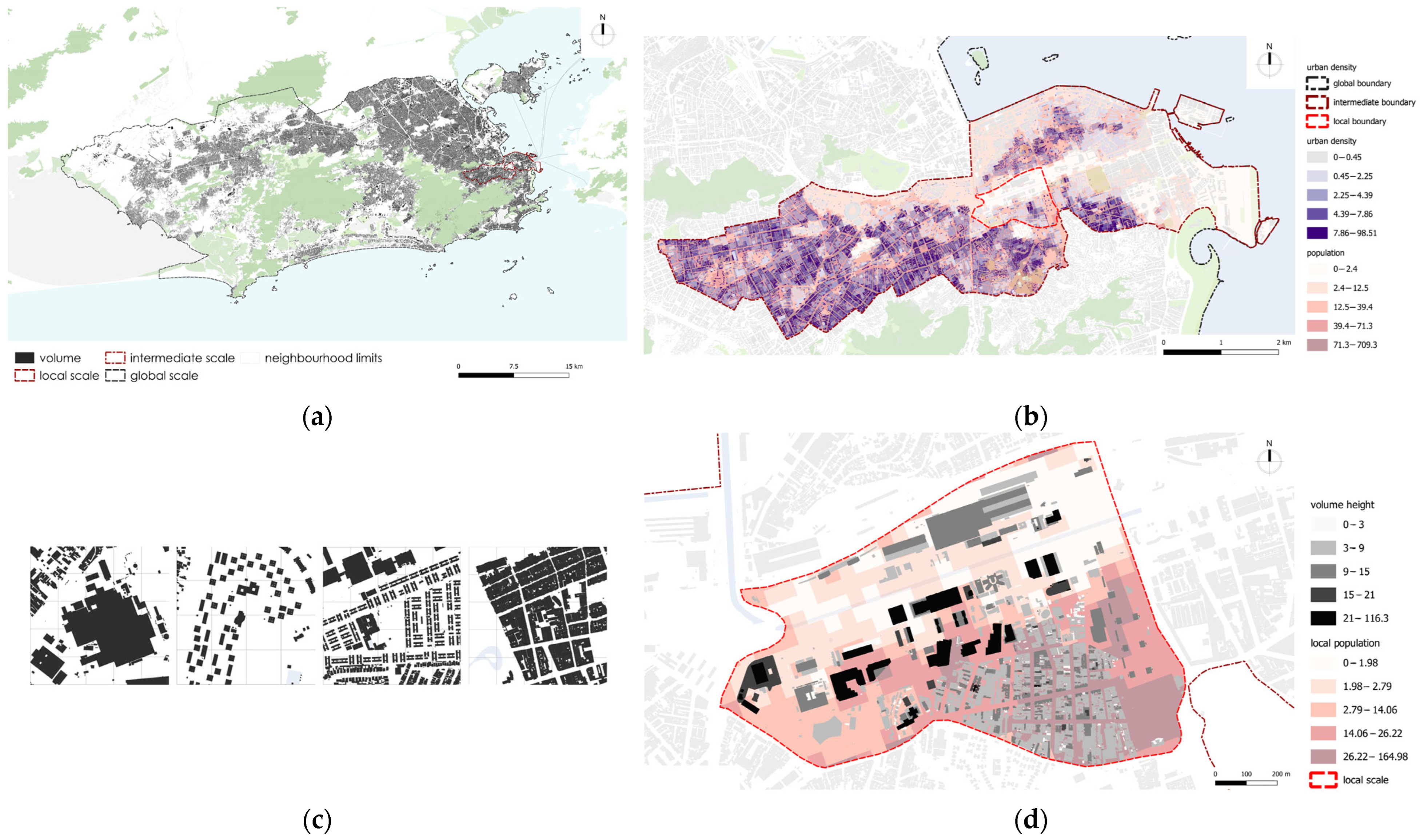
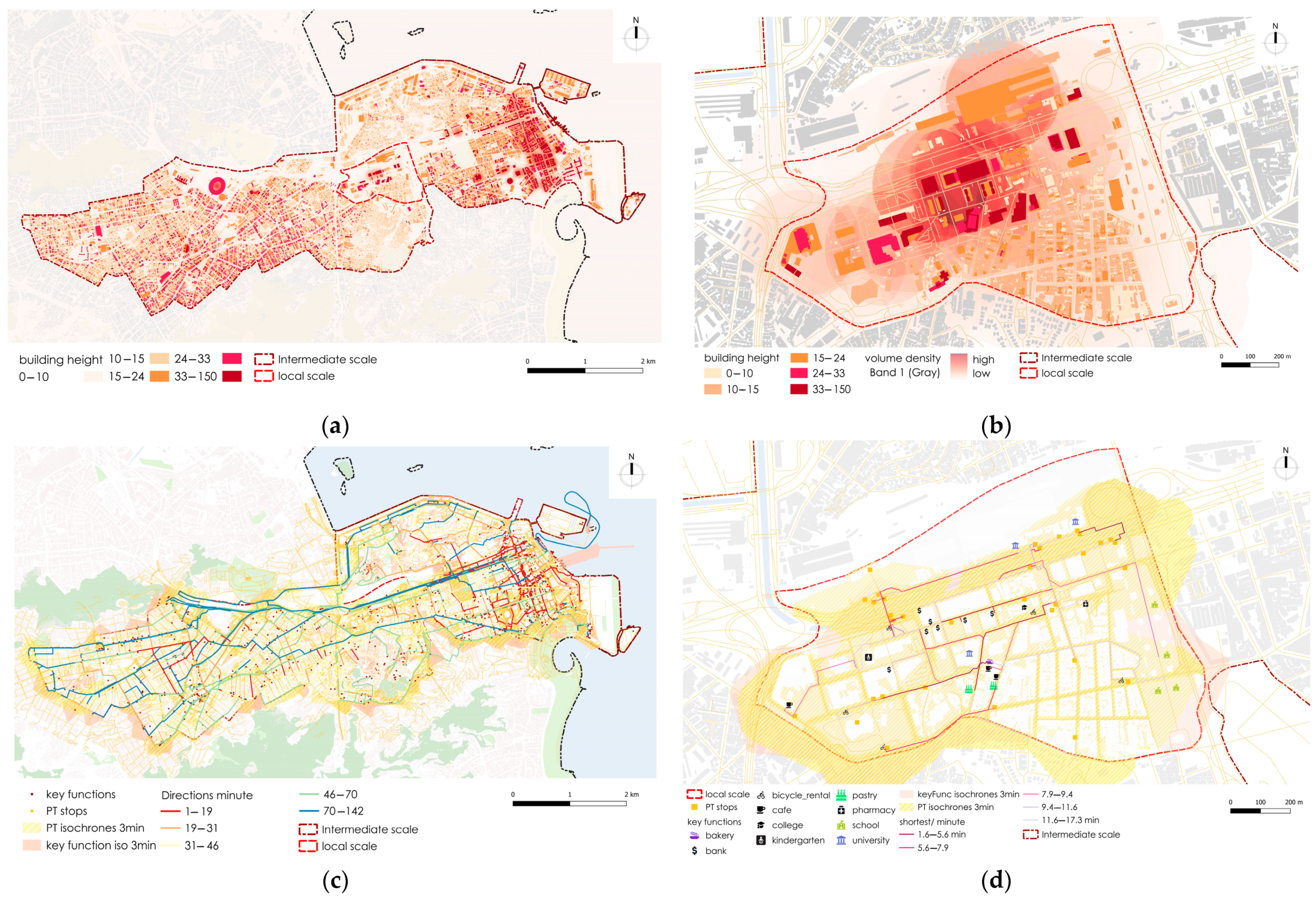
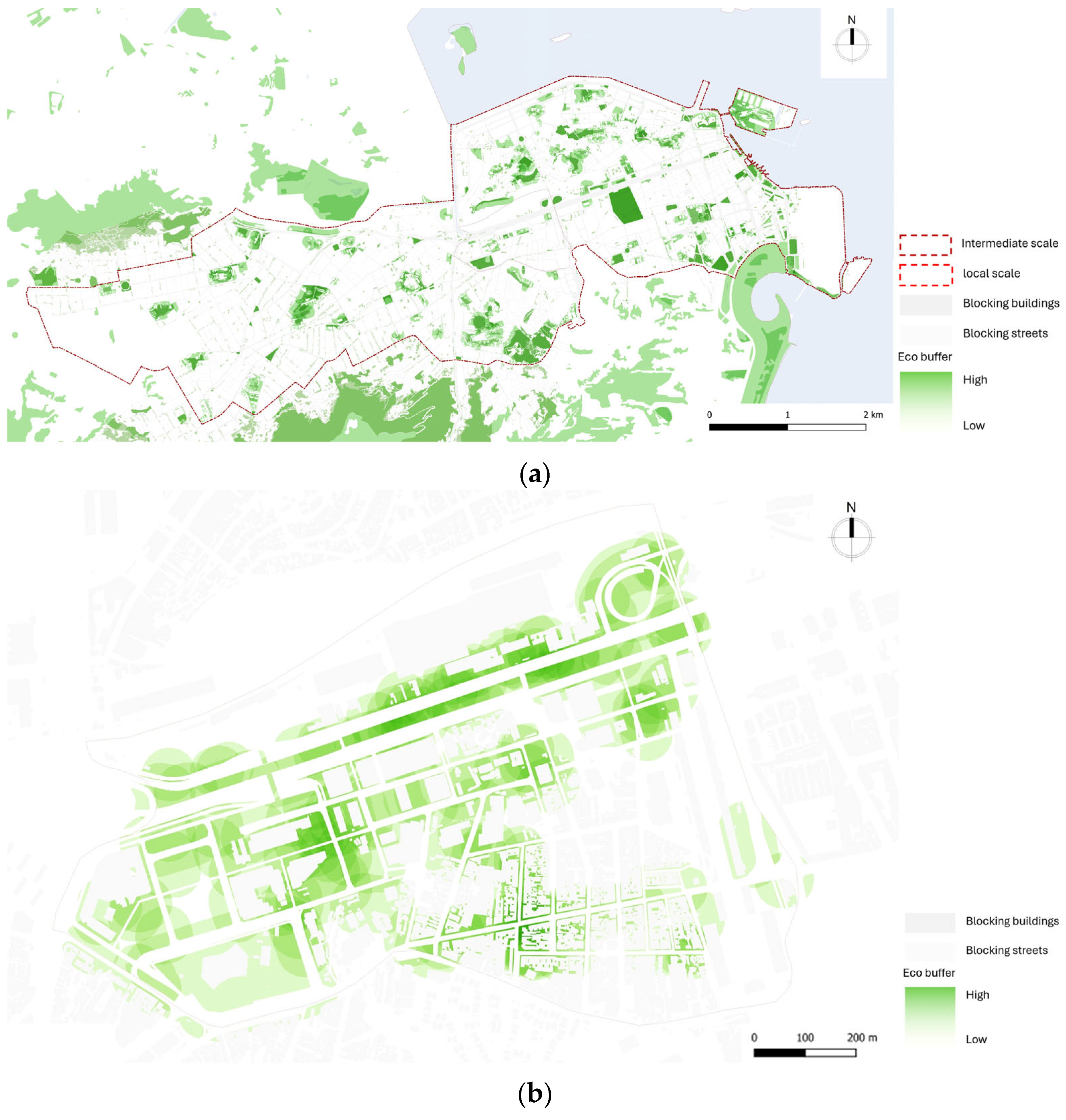
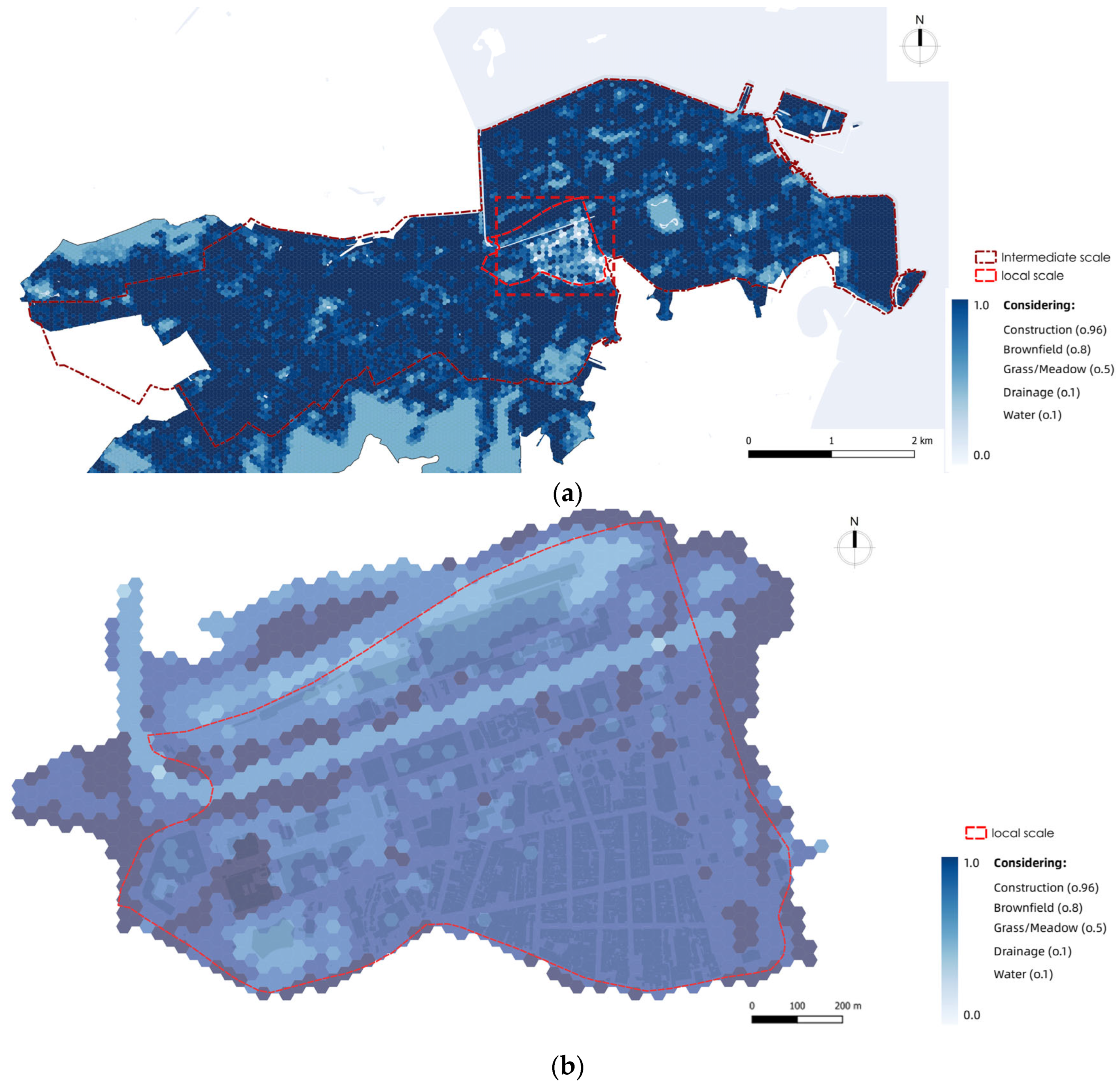

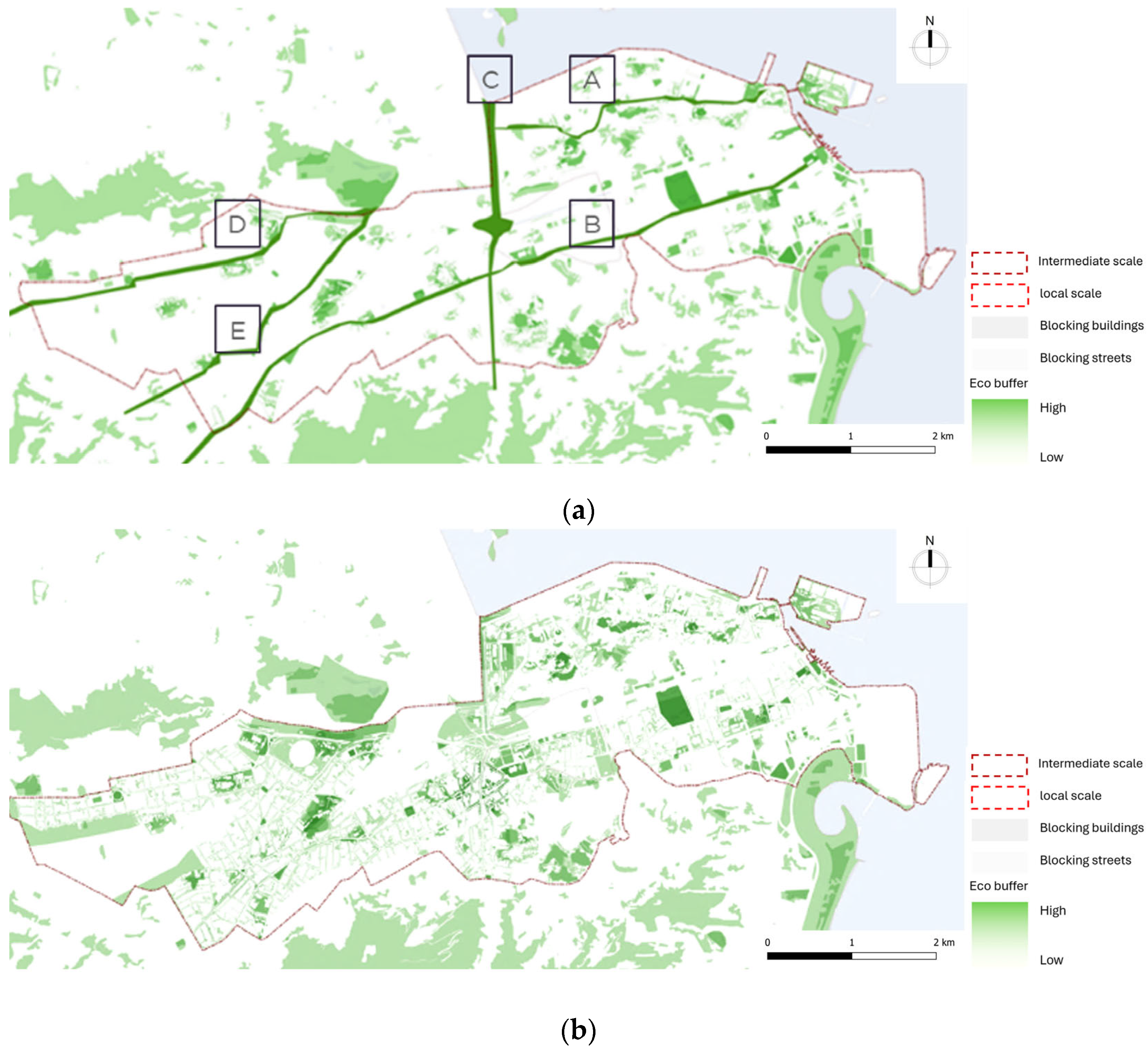
| Scale | Area (km2) | Population | Description |
|---|---|---|---|
| Global scale | 1200 | 6,211,223 [37] | The capital of the state of Rio de Janeiro. |
| Intermediate scale | 21 | 350,735 1 | 21 neighbourhoods, mainly the historic development of the city by the port and Centro, expanded to the west by Andarai, and Grajau. |
| Local scale | 1 | 7708 | Cidade Nova, the northeast region of Belo Horizonte, including the boundary defined by the REMIRIO project. |
| Data Category | Data Source | Application | Analysis Tool |
|---|---|---|---|
| Urban Geometry and Land Use | DATA.RIO [38] (Instituto Municipal de Urbanismo Pereira Passos, IPP) | Building footprints, heights, land cover classification for morphology analysis and UHI/flood surface runoff. | QGIS 3.34 “Prizren”, DepthmapX 0.8.0, Urbano (Grasshopper 1.0.0007) |
| Green Infrastructure | Cobertura Vegetal e Uso da Terra (2018) [41], OpenStreetMap (OSM) | Mapping green spaces, ecological value assessment, and fragmentation analysis for green continuity. | QGIS 3.34 “Prizren” |
| Climatic Data | ASHRAE Zone 1, EnergyPlus Weather (EPW) files [42] | Microclimate simulations (UHI), temperature differentials, and thermal performance of materials. | Ladybug 1.6.0/Dragonfly1.6.0 (Grasshopper 1.0.0007) [39] |
| Hydrological Data | USGS EarthExplorer [43] (30 m DEM), rational method (Q = C· I · A) | Slope, drainage density, floodwater depth, and runoff modelling for flood risk assessment. | QGIS 3.34 “Prizren”, Grasshopper 1.0.0007 |
| Anthropogenic Heat | Traffic-derived estimates (20 W/m2 baseline) | Modelling heat contributions from traffic and built environment for UHI analysis. | Ladybug 1.6.0/Dragonfly 1.6.0 (Grasshopper 1.0.0007) [39] |
| Population Data | DATA.RIO (Census 2022) [37], GPW (Gridded Population of the World) v4.11 | Spatial distribution of population for accessibility metrics (e.g., park proximity). | QGIS 3.34 “Prizren” |
| Ecological Metrics | Biodiversity-intactness index, Green View Index (GVI = (Gp/A) × 100) 1, landscape connectivity | Assessing green space functionality, connectivity, and ecosystem services. | QGIS 3.34 “Prizren”, custom scripts |
Disclaimer/Publisher’s Note: The statements, opinions and data contained in all publications are solely those of the individual author(s) and contributor(s) and not of MDPI and/or the editor(s). MDPI and/or the editor(s) disclaim responsibility for any injury to people or property resulting from any ideas, methods, instructions or products referred to in the content. |
© 2025 by the authors. Licensee MDPI, Basel, Switzerland. This article is an open access article distributed under the terms and conditions of the Creative Commons Attribution (CC BY) license (https://creativecommons.org/licenses/by/4.0/).
Share and Cite
Tadi, M.; Mohammad Zadeh, H.; Esmaeilian Toussi, H. Transforming Vulnerable Urban Areas: An IMM-Driven Resilience Strategy for Heat and Flood Challenges in Rio de Janeiro’s Cidade Nova. Urban Sci. 2025, 9, 339. https://doi.org/10.3390/urbansci9090339
Tadi M, Mohammad Zadeh H, Esmaeilian Toussi H. Transforming Vulnerable Urban Areas: An IMM-Driven Resilience Strategy for Heat and Flood Challenges in Rio de Janeiro’s Cidade Nova. Urban Science. 2025; 9(9):339. https://doi.org/10.3390/urbansci9090339
Chicago/Turabian StyleTadi, Massimo, Hadi Mohammad Zadeh, and Hoda Esmaeilian Toussi. 2025. "Transforming Vulnerable Urban Areas: An IMM-Driven Resilience Strategy for Heat and Flood Challenges in Rio de Janeiro’s Cidade Nova" Urban Science 9, no. 9: 339. https://doi.org/10.3390/urbansci9090339
APA StyleTadi, M., Mohammad Zadeh, H., & Esmaeilian Toussi, H. (2025). Transforming Vulnerable Urban Areas: An IMM-Driven Resilience Strategy for Heat and Flood Challenges in Rio de Janeiro’s Cidade Nova. Urban Science, 9(9), 339. https://doi.org/10.3390/urbansci9090339








